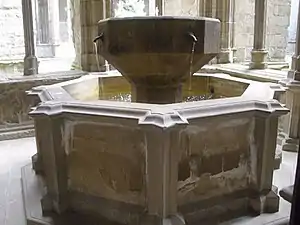Cantharus (Christianity)
A cantharus, also known as a phiala, is a fountain used by Christians for ablution before entering a church.[1][2][3] These ablutions involve the washing of the hands, face, and feet.[3] The cantharus is traditionally located in the exonarthex of the church.[2][4] The water emitted by a cantharus is to be running water.[5] The practice of ablutions before prayer and worship in Christianity symbolizes "separation form sins of the spirit and surrender to the Lord."[4] Eusebius recorded this practice of canthari located in the courtyards of churches, for the faithful to wash themselves before entering a Christian house of worship.[3] The practice has its origins Jewish practice of performing ablutions before entering into the presence of God (cf. Exodus 30:17–21).[2][1] Though canthari are not as prevalent anymore in Western Christianity, they are found in Eastern Christian and Oriental Christian churches.[1]

Gallery
Famous canthari found throughout Christendom:
 Cantharus of Monreale Cathedral (Italy)
Cantharus of Monreale Cathedral (Italy).jpg.webp) Cantharus at the Old Cathedral of Coimbra (Portugal)
Cantharus at the Old Cathedral of Coimbra (Portugal) Cantharus at Great Lavra Church (Greece)
Cantharus at Great Lavra Church (Greece)
See also
- Seven fixed prayer times
- Holy water font
- Home stoup, used by Christians for blessing oneself
- Hygiene in Christianity
- Lavabo, used by Christian priests in performing liturgical ablutions
- Lavatorium, used by Christians monks for communal washing before meals
- Maundy, the Christian rite of footwashing
- Sebil (fountain), an Islamic fountain for ritual ablutions
- Shadirvan, an Islamic fountain for ritual ablutions
- Tradition of removing shoes in the home and houses of worship
References
- Ian Bradley (2 November 2012). Water: A Spiritual History. Bloomsbury Publishing. ISBN 978-1-4411-6767-5.
It was probably out of the Jewish rite that the practice developed among early Christians, especially in the east, of washing their hands and feet before going into church. Early Christian basilicas had a fountain for ablutions, known as cantharus or phiala, and usually placed in the centre of the atrium. They are still found in some Eastern Orthodox churches, notably at the monastery of Laura at Mount Athos, where the phiala is an imposing structure in front of the entrance covered by a dome resting on eight pillars. In several Orthodox churches today worshippers take off heir shoes and wash their feet before entering the church just as Muslims do before going into a mosque.
- Soloviĭ, Meletiĭ M. (1970). Eastern Liturgical Theology: General Introduction. Ukrainian Catholic Religion and Culture Society of Etobicoke (Toronto) and Ukrainian Catholic Youth of Canada. p. 68.
In the Book of Exodus (30, 18-20) Aaron and his sons were required to wash before approaching the altar. Here water is used as a symbol of purification and expiation. But water is also the most common and most indispensable drink. ... So much was the practice a part of the life of the early Church, that in the period after Constantine the “cantharus”, or water fountain, became a standard fixture in the courtyard before the basilica to permit the faithful to purify themselves before entering the presence of God.
- Bingham, Joseph (1840). The antiquities of the Christian Church. W. Straker. p. 396.
In the middle of which stood a Fountain for washing as they entered into the Church, called Cantharus and Phiala in some authors. It is further to be noted, that in the middle of the atrium, there was commonly a fountain, or a cistern of water, for people to wash their hands and face, before they went into the church.
- Ferguson, Everett (8 October 2013). Encyclopedia of Early Christianity: Second Edition. Routledge. p. 6. ISBN 978-1-136-61158-2.
- Lowrie, Walter (1901). Christian Art and Archæology: Being a Handbook to the Monuments of the Early Church. Macmillan Publishers. p. 179.
In the middle of this court there was as a rule a fountain of running water (the cantharus) for the symbolical purification of those who ere about to enter the church.
